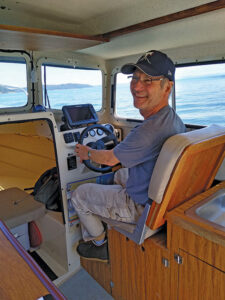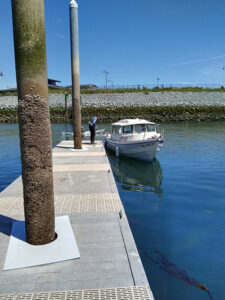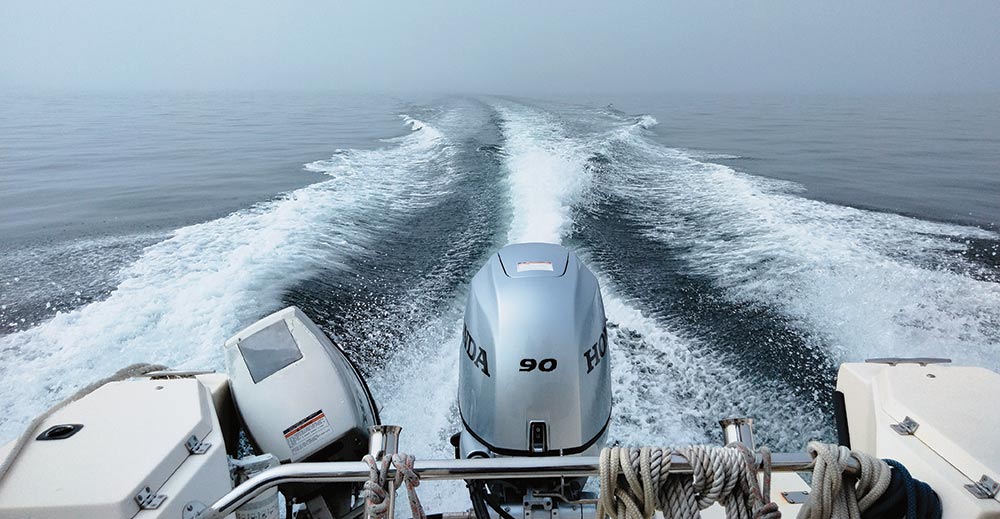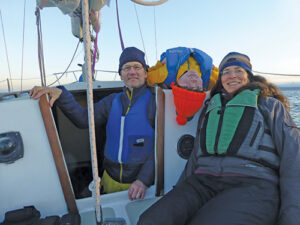
Longtime sailors chart a new course on a C-Dory.
It had been a long time since we trailer-launched a boat. Our past two boats — a Cal 27 Moondance and a Kent Ranger 24 Bora — had been moored in Foss Waterway for the last 10 years, so the fact that some boats are on trailers was something we had practically forgotten. “It will be like riding a bike,” I figured. “We’ll remember when we get there.”
For our first attempt to ramp launch our recently purchased C-Dory 22 Cruiser Sea Lab, we chose a midweek day because I figured there wouldn’t be too much traffic at the Point Defiance launch and hence fewer people watching or waiting on me. We would be performing several “firsts” at this launch, the biggest one being the first time we’d ever be in charge of a powerboat.
Long ago, we trailer launched our sailboats, and those boats were of a size that made it sensible. Our very first boat was Seashell, a Venture 17 complete with farm store hardware standing rigging. A few years later, Seashell was followed by our Kent Ranger 20, auklet, which I have especially fond memories of cruising on. With these boats, we learned that launch day was easy, but dependent on the tide being high enough. The effort really centered around raising the rig and not breaking anything, including ourselves, while doing so. We had the routine down, but it always took some time at the launch site to get it right — there were so many details.

When I pulled up at the ramp with Sea Lab and began to prep the boat, I took the tie-downs off and proceeded to circle the boat three or four times trying to remember what to do. Kim, the previous owner, had reminded us, “Never forget to put the plug in.” So I did that. Hmm… this was odd: there was nothing else to do. “This is too easy and there’s no ritual to it,” I thought, catching myself imbued with sailorly feelings about the boat, which was slightly distressing since we were now powerboat owners. Taking a breath and one final look over the boat, I overcame my anxiety and backed into the water, took off the bow strap and gave a light shove. The Sea Lab was afloat. Tekla had the lines and I drove the trailer up to park and ran back to the dock, excited by the newness of it all and more than a little relieved.
Already, I missed the ease of just going down to the marina, starting the Yanmar diesel with its chopping lettuce sound, shaking the docklines from their cleats, and being out there; but I decided I could get used to the tradeoff.
I had resolved that if I wanted to stay on the water, I would have to give up the rig climbing and upside-down-crammed-in-a-hole stuffing box adjusting lifestyle. I’m not old old, but I’m getting there, and our love for cruising our islands and inland waters runs deep. So, we determined it was the right time to make the jump to “easier” cruising, while it was still easy to do so. Don’t get me wrong, one of my favorite sayings is: “If there’s anything worth doing, it’s worth doing the hard way.” And this dude still abides. That said, there’s certainly an argument for easy.
By the time I got back to the launch dock, Tekla had the Sea Lab shipshape, fendered, and tied out at the end of the pier ready to sail. But of course, no sails. Now, we had to contend with the 90 horsepower Honda outboard that we had never started. Kim told me that both the primary motor and the 15 horsepower kicker worked well and, after giving them a quick look (and considering myself a reasonable judge of mechanical condition and character) I believed him. The used market for C-Dorys is unbelievably competitive, so we had essentially bought the boat sight unseen and driven six hours to get it. We didn’t have an opportunity for a sea-trial or to test the engines, so I was hoping for the best. I lowered the motor into the water, pulled the choke, squeezed the little hand pump bulb, yelled “Fire in the hole!” and turned the key. It started on the first crank, woo hoo!
After my initial excitement, my very next thought was, now what? We let the motor warm up for a while, planning our next move and engaging in discussion that revealed we weren’t quite sure what we were doing. We decided the best option would be for Tekla to untie lines and get on as she gave a gentle shove away from the dock, while I would simultaneously begin to reverse away.
All the boats I had ever piloted up to this moment had a tiller and a small motor. Motoring off a pier usually happened in a slow, measured manner; but not so in this case. As I tried to ease the control into reverse, the sticky throttle cable was reluctant. Of course, this demanded applying a little more pressure to the throttle arm. Then, too quickly it lurched into gear and suddenly all of the outboard’s 90 horses jumped into action. The prop whirred unthinkably fast, and we did a reverse donut right between the docks!
I checked to make sure Tekla was alright, before quietly scanning the area to discover that thankfully no one else was on the docks to see my un-seaman-like conduct. As I hastened the throttle back to neutral, I felt relieved. Somehow we hadn’t hit anything, and bonus — no witnesses! After a few calming breaths, our heart rates returned to normal. I carefully eased the throttle into forward gear without mishap. We slowly corkscrewed our way out of the launch area, around the breakwater, and into open water.
We motored along for quite a while at our customary 4-5 knots marveling at our Lowrance screen, another thing we had never before possessed. Our sailing was always accomplished with paper charts and a tiny handheld GPS with a 2-inch-by-2-inch screen in beautiful amber monochrome. At 10 inches, this new screen seemed like a big screen TV, and it was in color even. Soon, we adopted a Captain Ron attitude, and figured if anything was going to happen it would “happen out there.” It was time to see what Sea Lab could do.
Being a cautious sailor, I eased the throttle up to 1800 RPMs and felt the stern sink and the bow come up to a point where I couldn’t see anything except sky above the pulpit. It needed more, so I gave it more. Now, I had read about planing boats and have an understanding of how they are supposed to work. I’ve even ridden on a couple, but I had never brought one up on plane, and the noise and power of getting there was new to us. We were not entirely sure that this was the feeling we wanted while on the water. The peaceful quiet of sailing past the big jellies was blasted away by the outboard and soon we were traveling across the water at the extreme speed of 20 knots! It was a bit terrifying, initially.

In a short time, though, we settled into a comfort with it. I wanted to see how fast it could be, so I ran it up to 29 knots and that felt like something of a natural limit. It wasn’t long before we fell into daydreams, imagining where we could go with all that speed. We had done all of our cruising at small sailboat speed for so long, this was five times as fast.
We decided to run over to Dockton on Vashon Island, which has always been one of our go-to spots because of its proximity. Admittedly, “running” was not what we usually called it. Getting there was a big part of the experience on our previous boats. On Sea Lab, we arrived at the park in an unbelievably short time; so quickly in fact that we cruised around the corner to look at Quartermaster Marina, where we had never been. Throttling back to a gentler speed, we toured the inlet in a completely foreign fashion, feeling quite satisfied with our new ability to get to places we had previously missed because of the time it would take to get there.
Of course, we were still wrestling with the tradeoffs: peace for speed, journey for destination, experiencing the weather for pilothouse. From Quartermaster, we puttered our way back out into Dalco Passage and up the east side of Maury Island along the beach below the old gravel pit — a location we love to hike to when we tie up in Dockton Park.
It was clear right from the start that, as sailors turned powerboaters, we could audaciously go against nature, taking our time fiddling around bays and not worrying so much about missing slack current somewhere. All we have to do is grapple with the idea that we’re at a different stage of life, like sailors bucking the tide. That, and fill the tanks with fuel. On our last sailboat, a Cal 27 with the single cylinder diesel motor, there were a couple of summers that we only filled the 14-gallon diesel tank once in the season. Typically, our “season” on the water averages 30 to 40 days, so those 14 gallons went a long way. Granted, we did sail as much as we could which boosted our fuel economy, but still. We will have to adjust to the aspect that our fuel does not last as long now… and it smells like gas!

As we acclimate to our new boat and lifestyle, there are many times when we’re on the water and I find myself pining for the sail and long passage days in perfect sunny conditions. That’s not always how it actually was, but some of the best memories of my life involve sailing the incredible waters of the Pacific Northwest. By continuing our travels in a different mode, I hope we’ll make even more memories to light up our smiles when our water adventures can only be recalled from rocking chairs on the porch. Either way, we’ve launched into a new era, literally and figuratively.
Dennis Bottemiller
Dennis and his mate, Tekla, reside in Auburn, Washington and usually launch from Point Defiance to spend time on Sea Lab, their C-Dory 22 affectionately nicknamed “Boatswagen Bus.” When not playing with boats or guitars, Dennis can be found tending tropical Rhododendrons at the Rhododendron Species Botanical Garden.






